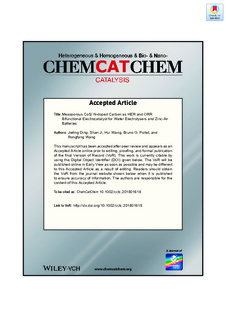Mesoporous CoS/ N‐doped Carbon as HER and ORR Bifunctional Electrocatalyst for Water Electrolysers and Zinc‐Air Batteries
Journal article, Peer reviewed
Accepted version
Permanent lenke
http://hdl.handle.net/11250/2595828Utgivelsesdato
2018Metadata
Vis full innførselSamlinger
Sammendrag
Hydrogen evolution reaction (HER) and oxygen reduction reaction (ORR) are two critical electrocatalytic reactions, involved in many sustainable and green electrochemical energy conversion and storage technologies. Transition metal‐based compound combined with carbon materials have been found to be effective catalysts toward the HER and ORR with great potential to replace conventional precious metal‐based catalysts. Herein, a low‐cost method is described for the fabrication and testing of sulfide (CoS)/carbon compound with high specific surface area and mesoporous structure by using peptone as raw material and NaCl as template. The obtained materials showed open structures composed of interconnected thin carbon nanosheets with transition metal‐based nanoparticles wrapped inside the carbon matrix. These as‐prepared materials were used as HER and ORR bifunctional catalysts for water electrolysis and Zn‐air battery. In the alkaline media, the optimized catalysts exhibited highly efficient electrocatalysis toward the HER. They also showed an outstanding ORR activity and durability which was found to be superior to commercial Pt/C catalysts. In an assembled primary Zn‐air cell containing the optimized sample, the open circuit voltage (OCV) was 1.44 V, higher than the value for Zn‐air cell containing Pt/C. The assembled Zn‐air cell delivered a power density of 119 mW cm−2 at 150 mA cm−2, higher than the Pt/C cell (97 mW cm−2 at 150 mA cm−2).
